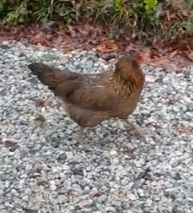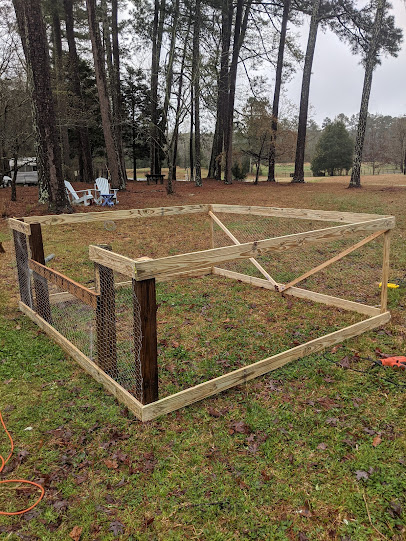We’ve answered the call to gather some Chicken Tractor Ideas at the Firefly. The presence of chickens at the place is part of the marketing plan, breakfast production and general atmosphere. Because of that we take some pride in this flock, and for the general well being we’re spending some effort in taking care of it.
The most important chicken tractor features are as follows: 1. Lightweight 2. Protects the Birds 3. Cheap to build and repair

Why are we telling you this?
There are several reasons. We want you to know that we are thoughtful, and enjoy human scale living. It’s also important that you know that we’re makers, and not destroyers. We are always making things here to make the place a little interesting.
What we really hope is that you are curious enough to visit, even if it is for just an afternoon. You can see what we have going on. If you book a stay, so much the better.
The Chicken Situation at the Firefly
Chickens arrived in the first cardboard box that was unloaded at the place. There are not enough of them to be a business. They’re more in the category of pets, the main one of which is Weezy who has been known to travel.
We write about chickens all the time. The last time we had a blog post was this one:
Hey, did you know we have a chicken store, with chicken apparel? Well you can get to it by clicking this link.
www.fireflymadison.com/chicken-store
Chickens aren’t for Everybody
So we have a big chicken coop with nesting box in the back. It’s 18X30 which would make it 540 square feet, bigger than a lot of houses in the world. The flock is about 20 chickens total.
This thing has its pros and cons. One of the pros, which some times a year is a con, is that it is in the shady part of the property. When it rains, it gets a bit muddy, and some of the crew likes for the chickens to walk around on the property to keep their feet from getting wet.
This is great for ambiance in that they greet the guests, and provide some entertainment. What is not all that great is the little bundle of joy that they leave in the place, and we are not talking about eggs.
So we are always experimenting for the best form of chicken management to solve some of the common chicken-related problems, and still take advantage of their giving of positive energy around the place.
The Chicken Tractor Alternate Designs
Since chickens and humans have co-evolved, we’re going to go out on a limb and say that the “chicken tractor” concept is ancient, and has been newly rediscovered.
Here is how it works: Instead of being in a fixed coop, you have a containment which is semi-portable. You push or pull this thing around the yard every few days.
What that does is allow chickens to do their normal behavior, namely walking around and foraging, in a controlled manner.
It also allows them to deposit their lovely fertilizer wherever you want it. In its purest form it works best for “meat chickens” but there are other options. So chicken tractor ideas are important to consider.
The Joel Salatin Version
The chicken tractor is a portable chicken coop with no bottom, to allow the chickens to scratch up the pasture as they feed. They also contribute their manure and other by-products to self-fertilize the same pasture. This is part of a technique called “regenerative farming.”
Joel Salatin is considered the current proponent in what is called “regenerative farming.” You can see the merits of this approach just in our little operation. We have contained chickens that scratch up a mud pit a few times a year, and uncontained ones, who wander free.
If you want an even bigger version, there are some commercial chicken coops out behind us on Dixie Highway that you can go by when you get here.
Joel Salatin’s theory is that the chicken tractor it is best for a variety of reasons to allow animals to keep some or all of their natural innate behavior. They grow best, are healthiest, and give better food. In this case, we’re talking about eggs.

As it applies to the chicken tractor, he has “moving containment.” He has a collection of 10X10X2-foot “floorless portable chicken shelters” that he pays someone to pull around on his farm.
He takes advantage of basically free chicken feed, since they scratch up his pasture much better than plowing. The chicken waste products, which are also free, are dispersed evenly. He runs these chickens right behind his beef livestock, so they clean up after them as well. At the end of the day, his motto is “let chickens be chickens” and it allows them to maintain something approaching normal chicken behavior.
We can have a conversation about the relative merits of this form of farming later on, while enjoying a nice beverage at our outdoor fireplace, but the theory is intriguing in that it involves less stink, less commercial food, and the chickens don’t get sick.
Here is Joel Salatin click love:
How does this apply to us?
We have an abundance of grass out front, which is the free food part. We’d like to at the very least rotate the flock through the front yard and keep it out of the patio and off of the porch.
So the idea of free chicken feed and no waste disposal is attractive.
The Justin Rhodes Chickshaw
Justin Rhodes has himself a YouTube channel, and a little publishing empire going on:
https://www.amazon.com/Justin-Rhodes

You may also feel free to look at this You Tube video:
He has the same basic theory about the mobile chicken coop except that he uses one of those portable solar powered electric fences to do his containment.
Here is how it works: He (or his child labor force) sets up his containment, and the chickens live in this little portable coop. This thing is a nesting box that keep the flock contained at night. Every day or two they move both the fence and the coop.
The benefit is that it is lighter and more kid-friendly. The drawback, of course, is that you have to go out and get the chickens into their tractor every night to keep the predators off of them. Except, that is, for chicken hawks which have no real problems getting to his flock.
Hence the little human-drawn buggy in the photo above.
Here, by the way, is the electric fence they use. You’re also going to need an energizer.
Benefits of the Chickshaw
Small, fun and portable, and the chickshaw itself is relatively cheap to build. Drawbacks? Well, there is the fact that you have to move the fence all the time, you have to keep the chickens’ wings clipped to keep them from flying over the fence, and the daily issue of boxing them up at night.
But the advantage is that you can put your little nesting box in the containment, and collect your eggs as you go. Justin mainly uses his flock for meat chickens as well, but is happy to collect free eggs in the process.
Also, maybe we don’t want to spend $400 on the project. We want to keep this thrifty.
The Amazon Theory
If you really wanted to, you could buy one of these things from Amazon. It is open-bottom, you have a pen along with the nesting box, and it might be lightweight enough to transport.
This thing is 3X7 and is missing several pieces of information: One is, how much does it weigh? The other is, how many chickens can be put in this thing? The third is: how hard is it to attach wheels to it? The fourth, which is probably the most obvious is, who is going to assemble it?
How Many Chickens per Coop?
According to “Chickens for Dummies” the answer is 2 square feet per bird. So in the above 21 square foot coop, you “should” be able to keep 10 birds, but that seems like a lot of birds for a small coop. We will have to further consider this.
Weight Reduction: Chicken Tractor using PVC Pipe
Here is an option of reducing the weight of this structure by using PVC:
This thing looks fairly luxurious. There are a couple of potential drawbacks.
For one, PVC as a material will break down over time, and become brittle. Since we want some durability, we’re resisting the idea:
The other is the ongoing problem of how to attach the chicken wire to it.
The Metal Cage
If we wanted to buy a $600 metal cage, and try to assemble it we could, but that still doesn’t solve the problem of moving it.
The Portable Option
This fellow has built a self-propelled chicken tractor, with included watering and feeding using a wheelchair motor, a remote control for a model plane, and a collection of PVC and plywood.
Neither the chickens or cat seem to be especially amused but you have to admire his ingenuity. The budget would have to be greater than zero, and you’d have to have some electronics skills.
We’re not saying “no” to the idea categorically. In this case the weight doesn’t matter, the relatively modest size is holding about five chickens, and it has some merits.
Chicken Tractor Ideas
So are we in the mood to experiment on this? We have to think about who will move it, what the budget is, and what the method of moving is. There is also need to worry about keeping predators off out of it.
We also want durability and cheapness. And ideally, it should be able to house a number of chickens and have a nesting box.
Are there options? It seems that there are.
We are always looking for ideas for the flock. If you have one, get back to us. For now, here is our starting point.

![]()
